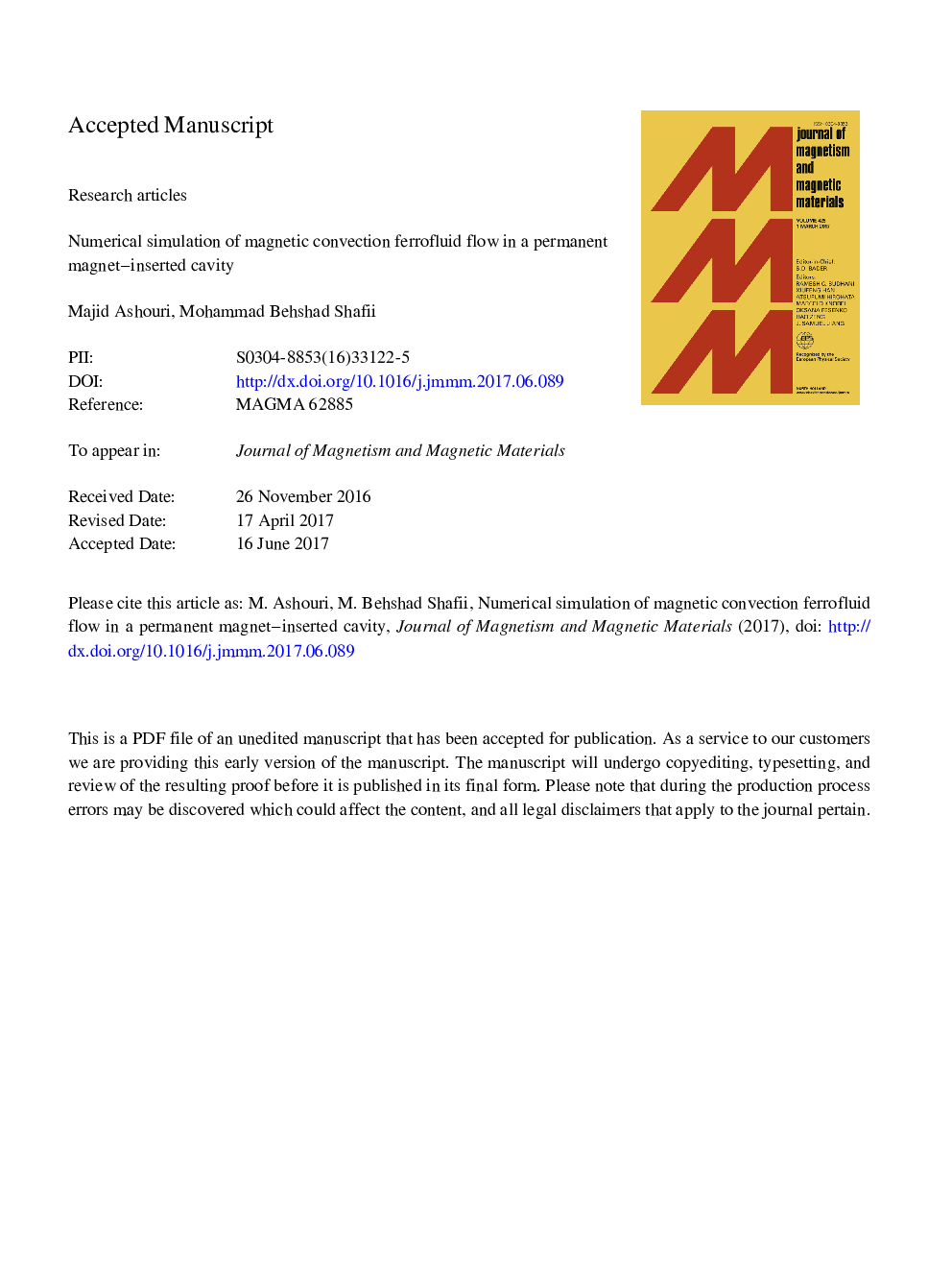| کد مقاله | کد نشریه | سال انتشار | مقاله انگلیسی | نسخه تمام متن |
|---|---|---|---|---|
| 5490231 | 1524779 | 2017 | 22 صفحه PDF | دانلود رایگان |
عنوان انگلیسی مقاله ISI
Numerical simulation of magnetic convection ferrofluid flow in a permanent magnet-inserted cavity
ترجمه فارسی عنوان
شبیه سازی عددی جریان فلوئوریدرینگ مغناطیسی در یک حفره مغناطیسی دائمی
دانلود مقاله + سفارش ترجمه
دانلود مقاله ISI انگلیسی
رایگان برای ایرانیان
کلمات کلیدی
ترجمه چکیده
انتقال حرارتی مغناطیسی در یک حفره مربع دو طرفه مانع شده به صورت عددی بررسی شده است. دیواره های حفره با دوشاخه های مختلف ثابت گرم می شوند و در دو طرف دیگر جدا می شوند. حفره با پراندل بالا پرتقال پر شده است. نیروی کنتراست توسط یک گرادیان میدان مغناطیسی یک آهنربا دائمی دارای عایق حرارتی که در مرکز حفره واقع شده است، ایجاد می شود. نتایج به دست آمده در فرم های ساده، ایزوترم، و تعداد نوستل برای مقادیر مختلفی از تعداد ریز مغناطیسی و اندازه آهنربا دائمی ارائه شده است. دو حفره بزرگ در حفره ایجاد می شود، جریان در جهت عقربه های ساعت در نیمه بالایی و در جهت عقربه های ساعت در نیمه پایین تر تولید می شود. علاوه بر این، در اطراف لبه های سطح آهنربا دائمی دیده می شود. استحکام گردش به طور یکنواخت با تعداد ریز مغناطیسی افزایش می یابد. گردش خون نیز با اندازه ذرات دائمی افزایش می یابد، اما در نهایت برای اندازه های بزرگتر سرکوب می شود. یافته شده است که به دلیل اثرات متقابل افزایش نیروی مغناطیسی و افزایش مقاومت در برابر جریان با افزایش اندازه، اندازه مطلوب برای مغناطیس دائمی وجود دارد. با افزایش تعداد ریز مغناطیسی یا نسبت دمای دیواره ایزوترمال، سرعت انتقال حرارت افزایش می یابد.
موضوعات مرتبط
مهندسی و علوم پایه
فیزیک و نجوم
فیزیک ماده چگال
چکیده انگلیسی
The magnetic convection heat transfer in an obstructed two-dimensional square cavity is investigated numerically. The walls of the cavity are heated with different constant temperatures at two sides, and isolated at two other sides. The cavity is filled with a high Prandtl number ferrofluid. The convective force is induced by a magnetic field gradient of a thermally insulated square permanent magnet located at the center of the cavity. The results are presented in the forms of streamlines, isotherms, and Nusselt number for various values of magnetic Rayleigh numbers and permanent magnet size. Two major circulations are generated in the cavity, clockwise flow in the upper half and counterclockwise in the lower half. In addition, strong circulations are observed around the edges of the permanent magnet surface. The strength of the circulations increase monotonically with the magnetic Rayleigh number. The circulations also increase with the permanent magnet size, but eventually, are suppressed for larger sizes. It is found that there is an optimum size for the permanent magnet due to the contrary effects of the increase in magnetic force and the increase in flow resistance by increasing the size. By increasing the magnetic Rayleigh number or isothermal walls temperature ratio, the heat transfer rate increases.
ناشر
Database: Elsevier - ScienceDirect (ساینس دایرکت)
Journal: Journal of Magnetism and Magnetic Materials - Volume 442, 15 November 2017, Pages 270-278
Journal: Journal of Magnetism and Magnetic Materials - Volume 442, 15 November 2017, Pages 270-278
نویسندگان
Majid Ashouri, Mohammad Behshad Shafii,
